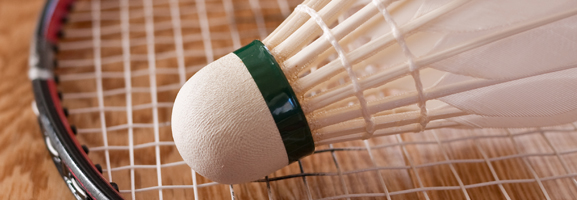A guide to badminton rackets
Choosing the right badminton racket for you is a personal process, nobody can tell you which is the right racket to choose, you have to spend time testing a variety of rackets before you find the perfect match.

As your badminton experience grows, you'll find it easier to choose the right badminton racket as you'll have developed a feel or instinct for what you like or dislike, but equally it's important to ask the right questions before you make a purchase. Making the wrong assumptions could affect your performance.
When buying a badminton racket the three main things to take into consideration are the racket head's shape, its weight and its shaft flexibility, all of which will determine the racket's effectiveness and style.
Shape
Badminton rackets come with two distinctive head shapes, oval and isometric. Oval heads are typically found on cheaper, lower-end rackets, while isometric heads are more common on the majority of rackets. The benefit of an isometric racket is that it has a larger sweet spot than an oval head.
Weight
Badminton rackets come in three categories, Head-Heavy, Even-Balance and Head-Light. Below, Newitts provides an accurate description of each category:
Head-Heavy rackets - as the name suggests, Head-Heavy badminton rackets have the mass shifted towards the head. Head-Heavy rackets are popular with players who like to play a powerful game from the back of the court. A heavier head can increase the power of a players clears and smashes.
Head-Light rackets - have the mass shifted towards the handle and therefore contain a lighter head. These type of rackets are a popular choice amongst club badminton players as the head and frame of the racket contain far less mass and are therefore easier to manipulate and swing. Head-Light rackets are good for returning smashes as players need to react quickly. They are also better suited when playing shots at the net.
EVEN Balance rackets - have the mass distributed evenly throughout the racket. They are aimed at providing players with a compromise between Head-Heavy and Head-Light rackets, by providing enough power from the back and enough control and flexibility at the front. If you don't yet play in a specific position on the badminton court, an Even-Balance racket is a good choice as the racket is suited to all types of shots and can help beginners to develop all-round game.
Finding a Racket's Balance - a tip to finding out whether a racket is head-heavy or not is to balance the shaft of the racket on your finger. Find the point at which the racket is completed balanced on your pointed finger. If your finger is in the exact middle of the shaft, the racket is balanced. If your finger is past the midpoint towards the racket head, then it’s head-heavy. If the balance point is towards the handle, it’s head-light.
Shaft Flexibility
This is as important as weight when choosing a badminton racket. The correct level will be dependent on your wrist/arm speed. Rackets are characterised as 'Flexible', 'Medium' or 'Stiff', and the way to choose the right one for you if to consider your arm speed. The stronger your swing speed, the more you'll benefit from a stiffer shaft. If your arm speed is slower and smoother, you'll be better suited to a flexible shaft. Beginners will benefit far more from a flexible shaft whilst advanced players tend to favour stiffer shafts which compliment their more advanced technique.
Specifications
When purchasing a badminton racket, there are a number of specifications marked on the rackets to look out for.
Weight - the weight of a racket is described by using the letter 'U' with a number preceding it. The smaller the number, the heavier the weight, for example, 3U (85-89g) is heavier than 4U (80-84g).
Grip size - the grip size is described using the letter 'G', the smaller the number the handle size.
Racket tension - is identified by 'x lb to y lb' which describes the minimum to the maximum stringing tension recommended.
Beginners are recommended to play with a tension closer to the lower end to provide additional power to them.
Do I need a new one?
Do not be blinded by the constant marketing from racket companies who make your believe you simply must have a certain new racket in order to improve your performance. If your performance isn't up to scratch, a coaching course or a coach will improve your performance a lot more than a new racket can. However, if you racket has an obvious crack or is looking worn, it's probably the right time to change it, or at least consider a restring - a good restring can transform the performance of a racket and is therefore a good option if string tension in your racket is lacking.
